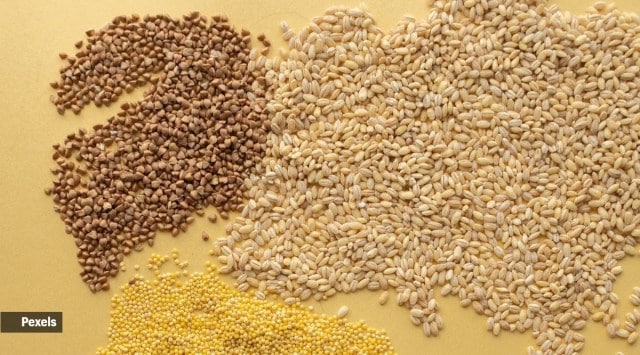- India
- International
Why millets are better than rice, wheat or your breakfast cereal for diabetes, heart and weight loss
Not for nothing are millets being called the next superfoods. Experts break down what makes them the perfect recipe for future-proofing our lives
 One of the many benefits of millets is that they are gluten free and ideally suited for people with gluten allergy and irritable bowel syndrome.
(Representative image of millets/Pexels)
One of the many benefits of millets is that they are gluten free and ideally suited for people with gluten allergy and irritable bowel syndrome.
(Representative image of millets/Pexels)Replacing your white rice with bajra rotis and switching your breakfast bread and cereal with a ragi uttapam can help you keep your blood sugar levels in check, lose weight and prevent heart damage. And come to think of it, they can easily agree with our systems, considering that they were traditionally used in our diet quite liberally during the bronze age.
“As we became an agricultural society, millets became relegated to being an animal food. We have about 300 varieties of millets in our country and in climate-conscious times, these use less water, are heat-resistant and still nutrient-dense. Besides, they can soak up maximum carbon dioxide from the atmosphere and release oxygen. So, they are environmentally-resilient and grow abundantly to be everybody’s superfood. They are a super cocktail of body-friendly nutrients,” says Dr Anuja Agarwala, former senior dietitian, Department of Paediatrics, AIIMS. With the government promoting the use of millets and documenting their heritage, and the United Nations declaring 2023 as the International Year of Millets, let’s look at our superfood.
Why are millets better for diabetics than all our carb staples?
(1) Low Glycaemic Index: Millets like jowar, bajra and ragi have a much lower glycaemic index – a measure of how much a food increases your blood glucose levels – as compared to rice and wheat flour. “When we suggest any food item to diabetics, we look at its glycaemic index. For bread, this is a very high 90, for dalia it is around 30 or 40. The glycaemic index of all millets is below 50, making them a food of choice,” says Ritika Samaddar, Regional Head, Department of Clinical Nutrition and Dietetics at Max Super Speciality Hospital.
(2) High-fibre ensures there is never hyper or hypoglycaemia: Not only are millets low in glycaemic index, the amount of fibre they contain is also higher than what is found in rice, wheat flour, maida or cornflakes. The high fibre content means they help in achieving satiety faster, thereby reducing the amount that people consume. “They slow down sugar spikes as the glucose gets released very gradually into the bloodstream. This stabilises blood sugar levels. They are never high, nor do they fall below desired levels,” says Dr Agarwala. “In this respect, millets are better than cereals, which are sometimes available in refined and processed forms. Millets are coarse and complex, taking time to be broken down,” she adds. Dr Swatee Sandhan, senior dietician at Jupiter Hospital, Pune, says, “The indigestible portion (insoluble fibres) of millets further works to slow down and regulate the absorption of carbohydrates and fats, thus maintaining blood sugar levels. Further, an increase in adiponectin concentration may improve insulin sensitivity for diabetics.”
How are millets good for heart health?

According to Dr Agarwala, millets contain good fats and can significantly control triglycerides and cholesterol. How does this happen? As Dr Sandhan says, “The Niacin or vitamin B3 content in millets is effective in lowering oxidative stress and high levels of cholesterol and triglycerides that are risk factors for heart diseases.”
The risk of developing cardiovascular diseases can be diminished by a regular consumption of millets, according to a study led by Hyderabad’s International Crops Research Institute for the Semi-Arid Tropics (ICRISAT), published in the journal Frontiers in Nutrition. Participants were given 50 to 200 g of millets per day for about four months. They reduced cholesterol by eight per cent, LDL or bad cholesterol by 10 per cent and lessened the load of triglycerides. These contributed to almost seven per cent decrease in body mass index (BMI) of the participants. Moreover, millets pushed down diastolic blood pressure readings by 5 per cent.
How do millets improve gut health?
(1) Gluten-Free: One of the many benefits of millets is that they are gluten free and ideally suited for people with gluten allergy and irritable bowel syndrome, says Samaddar. Dr Sandhan adds, “Besides, millets stimulate the growth of probiotics within the microbiome which play a role in gut health and micro nutrient absorption.” This greatly helps those with celiac diseases, according to Dr Agarwala.
(2) “The fibre content in millets contributes to digestive health and helps regulate bowel movements, flushing out toxins,” says Dr Sandhan.
Good for proteins, vitamins and minerals: Dr Agarwala says that millets are repositories of “high proteins, vitamin A, C (helps in the absorption of iron) vitamin B complex, magnesium, calcium and phosphorus.” Samaddar says ragi is high in calcium content, while bajra and jowar have a high iron content that can improve their deficiencies.
So, how do millets help in managing weight loss?
Obesity is one of major risk factors for hypertension, diabetes and heart diseases. Millets promote weight-loss as their fibre density and protein guarantee satiety over a long time. Besides, the Little millet contains 5.2 grams of mostly unsaturated fat that ensures a healthy metabolism. That in the end helps you drop body fat.
How can you integrate millets in your diet?
“The best thing about millets is that you can make them a part of your breakfast, your main meal as well as snacks,” says Samaddar. “The morning bowl of cornflakes or bread can easily be replaced by ragi porridge or uttapam. For the main course, bajra can be integrated in the form of khichdi or jowar can be used to make rotis. As for snacks, it is better to substitute biscuits or fried stuff with makhanas. The best thing about millets is that they are readily available at reasonable prices because they are grown locally. So, they are no-fuss and safe,” she adds.
A word of caution from her, though, is that millets, despite their good qualities, still have calories just like rice and rotis. “Portion control remains important even with millets. We cannot overdo anything just because they are healthier.”
More Lifestyle
Apr 25: Latest News
- 01
- 02
- 03
- 04
- 05





































